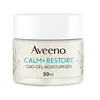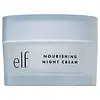What's inside
What's inside
 Key Ingredients
Key Ingredients

 Benefits
Benefits

 Concerns
Concerns

 Ingredients Side-by-side
Ingredients Side-by-side

Water
Skin ConditioningGlycerin
HumectantDimethicone
EmollientCetearyl Olivate
Avena Sativa Kernel Flour
AbrasiveAvena Sativa Kernel Extract
AbrasiveChrysanthemum Parthenium Flower/Leaf/Stem Juice
AntioxidantEthylhexylglycerin
Skin ConditioningPentylene Glycol
Skin ConditioningC13-14 Isoparaffin
EmollientPolyacrylamide
Dimethiconol
EmollientSorbitan Olivate
EmulsifyingSynthetic Beeswax
Emulsion StabilisingLaureth-7
EmulsifyingDimethicone Crosspolymer
Emulsion StabilisingCarbomer
Emulsion StabilisingSodium Hydroxide
BufferingCitric Acid
BufferingSodium Metabisulfite
AntioxidantBHT
AntioxidantPhenoxyethanol
PreservativeChlorphenesin
AntimicrobialSodium Benzoate
MaskingPotassium Sorbate
PreservativeWater, Glycerin, Dimethicone, Cetearyl Olivate, Avena Sativa Kernel Flour, Avena Sativa Kernel Extract, Chrysanthemum Parthenium Flower/Leaf/Stem Juice, Ethylhexylglycerin, Pentylene Glycol, C13-14 Isoparaffin, Polyacrylamide, Dimethiconol, Sorbitan Olivate, Synthetic Beeswax, Laureth-7, Dimethicone Crosspolymer, Carbomer, Sodium Hydroxide, Citric Acid, Sodium Metabisulfite, BHT, Phenoxyethanol, Chlorphenesin, Sodium Benzoate, Potassium Sorbate
Water
Skin ConditioningDimethicone
EmollientButylene Glycol
HumectantEthylhexyl Palmitate
EmollientHydrogenated Polyisobutene
EmollientButyrospermum Parkii Butter
Skin ConditioningSimmondsia Chinensis Seed Oil
EmollientGlycerin
HumectantCetearyl Olivate
Sorbitan Olivate
EmulsifyingAloe Barbadensis Leaf Extract
EmollientCucumis Sativus Fruit Extract
EmollientCetearyl Alcohol
EmollientStearic Acid
CleansingDimethiconol
EmollientXanthan Gum
EmulsifyingSodium Hyaluronate
HumectantTriethanolamine
BufferingAcrylates/C10-30 Alkyl Acrylate Crosspolymer
Emulsion StabilisingTocopheryl Acetate
AntioxidantSodium Dehydroacetate
PreservativeSaccharum Officinarum Extract
MoisturisingVaccinium Myrtillus Fruit/Leaf Extract
AstringentCitrus Sinensis Fruit Extract
AntioxidantCitrus Limon Fruit Extract
MaskingDisodium EDTA
Phenoxyethanol
PreservativeCaprylyl Glycol
EmollientWater, Dimethicone, Butylene Glycol, Ethylhexyl Palmitate, Hydrogenated Polyisobutene, Butyrospermum Parkii Butter, Simmondsia Chinensis Seed Oil, Glycerin, Cetearyl Olivate, Sorbitan Olivate, Aloe Barbadensis Leaf Extract, Cucumis Sativus Fruit Extract, Cetearyl Alcohol, Stearic Acid, Dimethiconol, Xanthan Gum, Sodium Hyaluronate, Triethanolamine, Acrylates/C10-30 Alkyl Acrylate Crosspolymer, Tocopheryl Acetate, Sodium Dehydroacetate, Saccharum Officinarum Extract, Vaccinium Myrtillus Fruit/Leaf Extract, Citrus Sinensis Fruit Extract, Citrus Limon Fruit Extract, Disodium EDTA, Phenoxyethanol, Caprylyl Glycol
 Reviews
Reviews

Ingredients Explained
These ingredients are found in both products.
Ingredients higher up in an ingredient list are typically present in a larger amount.
Cetearyl Olivate is an emulsifier and texture enhancer. It is derived from the fatty acids of olive oil and Cetearyl alcohol, and is biodegradable.
As an emulsifier, it is used to prevent oils and waters from separating. It can also
Manufacturers use the name Olivem 1000. This ingredient has been found to preserve the natural microbiome of skin. Having a healthy microbiome helps keep our skin healthy and protects against harmful bacteria. This ingredient is grouped with Sorbitan Olivate under the name Olivem 1000.
Learn more about Cetearyl OlivateDimethicone is a type of synthetic silicone created from natural materials such as quartz.
What it does:
Dimethicone comes in different viscosities:
Depending on the viscosity, dimethicone has different properties.
Ingredients lists don't always show which type is used, so we recommend reaching out to the brand if you have questions about the viscosity.
This ingredient is unlikely to cause irritation because it does not get absorbed into skin. However, people with silicone allergies should be careful about using this ingredient.
Note: Dimethicone may contribute to pilling. This is because it is not oil or water soluble, so pilling may occur when layered with products. When mixed with heavy oils in a formula, the outcome is also quite greasy.
Learn more about DimethiconeDimethiconol is a silicone that resembles the popular dimethicone. Like other silicones, it is an emollient. Emollients create a thin film on skin to prevent moisture from escaping.
This ingredient helps to create a silky texture and improve spreadability. Due to its high molecular weight and thickness, it is often combined with cyclopentasiloxane.
Glycerin is already naturally found in your skin. It helps moisturize and protect your skin.
A study from 2016 found glycerin to be more effective as a humectant than AHAs and hyaluronic acid.
As a humectant, it helps the skin stay hydrated by pulling moisture to your skin. The low molecular weight of glycerin allows it to pull moisture into the deeper layers of your skin.
Hydrated skin improves your skin barrier; Your skin barrier helps protect against irritants and bacteria.
Glycerin has also been found to have antimicrobial and antiviral properties. Due to these properties, glycerin is often used in wound and burn treatments.
In cosmetics, glycerin is usually derived from plants such as soybean or palm. However, it can also be sourced from animals, such as tallow or animal fat.
This ingredient is organic, colorless, odorless, and non-toxic.
Glycerin is the name for this ingredient in American English. British English uses Glycerol/Glycerine.
Learn more about GlycerinPhenoxyethanol is a preservative that has germicide, antimicrobial, and aromatic properties. Studies show that phenoxyethanol can prevent microbial growth. By itself, it has a scent that is similar to that of a rose.
It's often used in formulations along with Caprylyl Glycol to preserve the shelf life of products.
Sorbitan Olivate is created from the fatty acids in olive oil and sorbitol.
This ingredient is an oil in water emulsifier. It helps stabilize a product by preventing oils and waters from separating. Sorbitan Olivate also helps hydrate the skin.
Manufacturers sell sorbitan olivate under the name OliveM 1000. OliveM 1000 a multifunctional ingredient. It is self-emulsifying. According to a manufacturer, OliveM 1000 does not disrupt natural skin biome.
Due to its olive oil base, this ingredient may not be fungal-acne safe.
Learn more about Sorbitan OlivateWater. It's the most common cosmetic ingredient of all. You'll usually see it at the top of ingredient lists, meaning that it makes up the largest part of the product.
So why is it so popular? Water most often acts as a solvent - this means that it helps dissolve other ingredients into the formulation.
You'll also recognize water as that liquid we all need to stay alive. If you see this, drink a glass of water. Stay hydrated!
Learn more about Water